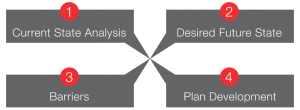Most high-performing firms that are successful over the long term are those which truly embrace strategic planning. If you have been part of a strategic planning process in your firm and are still skeptical about the importance of such a process, you should revisit the goals of your firm’s last two strategic planning sessions and assess how your firm has changed as a result. You will likely be amazed!
Walter P Moore has been in business for 84 years; its latest comprehensive strategic plan was developed in 2012 and is currently being implemented. The firm has the benefit of the historical perspective of the last five strategic plans that outlined its trajectory and validated the importance of building upon previous strategies. Walter P Moore’s successful strategic planning under the author’s leadership is the basis for this article.
Planning Framework
Getting Started
Ideally you want to start the process by having the firm’s senior leadership team agree on the need for a new strategic plan. This should be followed by hiring the strategic planning consultant, providing the selected consultant with necessary firm background and deciding on two important facets of the proposed strategic planning work – (i) the ideal number of core team members and (ii) the methodology for the strategic planning session. You want to have the largest number of people in the room that the facilitator is comfortable including, without any adverse effects on sessions for the chosen strategic planning approach. This will afford you greater flexibility on the issue of being inclusive with team members from across the firm who are at different stages of their professional career.
Selection of the core group should be well thought out and incorporate new leaders within the firm as well as senior leadership for a balanced perspective. Preferably, these core strategic planning team members are either principals or senior project managers. Consistent communication firm-wide about the ongoing process can build excitement, especially among those not actively involved in the planning sessions. These people “outside the room” should be engaged for various efforts, increasing engagement and buy-in.
Deciding on an Approach
There are many approaches that can be used for comprehensive strategic planning. For example, you could chose to conduct a vision-based, goal-based, issue-based, or scenario-based planning session. Some of the most widely used books which should be read prior to deciding on a strategic planning approach include The Balanced Scorecard by Kaplan and Norton, Blue Ocean Strategy by Kim and Mauborgne, and Good to Great by Collins. Each approach has its special nuance and benefit. However, whichever approach is ultimately chosen, the successful implementation of the resulting initiatives requires a strong commitment from the core strategic planning team.
Hiring a Facilitator
Working with an expert facilitator knowledgeable about your selected approach, and one who is intimately familiar with firms in the A/E/C space, is critical. Indeed, most successful strategic planning efforts require firms to hire an outside specialty consultant to facilitate the process. The external facilitator, by virtue of being an outsider, has tremendous freedom of expression and inquiry, and can maintain objectivity, which is understandably difficult to do from an insider perspective.
At Walter P Moore, the external facilitator who was selected used The Balanced Scorecard approach to guide five strategic planning sessions that spanned a 12-month period for the 2012 strategic planning. The session was a goal-based strategic planning session which was tested for alignment with the firm’s overall vision. The core strategic planning group of twenty-two leaders met for two days for each of the five sessions. These meetings were held within Walter P Moore’s facilities, which made it efficient from a logistics point of view and also signaled to others in the office that the firm’s leaders were planning the future of the firm in plain view. When working in your own facilities, it is even more important to stay focused and observe the ground rules. There were always assignments between the sessions for the entire group of twenty-two. The facilitator was very successful in making sure that the conversations at these sessions were not dominated by a few of the most outspoken in the room.

Culture and strategy are intertwined.
Assessing Firm Culture
For strategic initiatives to be successful, a supportive cultural environment is a must. It is critically important to seek the answer to “How are things done within the firm?” Personal mastery guru David Aitken of the Aitken Leadership Group says, “Any good strategy is going to depend on culture to support it. So culture and strategy become synergistic, part of a system diagram.” Hence, knowing the cultural predisposition of your firm is an important first step in a successful strategic planning process.
Conducting a cultural scan at the early stages of the strategic planning process is also a great way to engage all members of your firm. Typically, your strategic planning consultant will need to depend on a specialized personal mastery expert to develop the parameters of a cultural scan and then interpret the findings. There are well-established ways in which organizational behavior experts collect valuable qualitative data through employee surveys with respect to the cultural aspects of a given firm.
At Walter P Moore, all employees responded to a confidential survey that helped develop the cultural scan for the firm. From the data, the firm recognized the collective wisdom of how employees viewed what made Walter P Moore successful in the past, how things get done, and how they envisioned the firm’s future – very valuable insight for all involved. It was also recognized that, as a firm, organic growth was preferred over growth through mergers and acquisitions because it allows maintenance and reinforcement of its culture across the firm. Walter P Moore has made just four acquisitions in its history, so an acquisition is rare. Culture is important; hence, the firm is much more deliberate about determining the cultural fit in the due diligence process as it approaches any acquisition opportunities for growth.

Steps for strategic planning.
Four Basic Steps to Strategic Planning
Expecting linearity in the strategic planning process is unrealistic. The overall process is highly non-linear; hence, having a high level of comfort and trust in the selected facilitator is of utmost importance. The facilitator must guide the sessions while retaining the flexibility to modify the direction of the sessions to elicit open dialogue concerning the four basic steps to strategic planning – Current State Analysis, Desired Future State, Understanding of Barriers, and Development of a Strategic Plan. These steps do not necessarily occur in sequence.
Rod Hoffman, CEO of S&H Consulting, a strategic planning firm, likes to use The Balanced Scorecard as a framework for strategic planning sessions. Hoffman says, “Strategic planning is about connecting the dots so that everyone can see the picture.” A comprehensive strategic planning exercise typically requires multiple sessions over multiple days. The benefit of having the core team attend all of these sessions is the continuity component, and the team building that happens through group exercises during the sessions and informal conversations outside of the sessions.
1.0 Current State Analysis
Context for the current state analysis is established by restating the vision, mission, and core values, and by sharing the updated firm-wide cultural scan with the core strategic planning group. It is critical for any strategic planning exercise to do a deep dive into the current state of the firm, and the current internal environment as perceived by the internal core team, members of the firm, and clients of the firm. To understand the current state of the firm, a basic Strengths, Weaknesses, Opportunities, Threats (SWOT) analysis should be conducted by the core team. In addition, key production leaders who may not be part of the core strategic planning group can be surveyed for additional SWOT data points.
A select group of the firm’s clients can be surveyed, via a series of prepared questions, on their thoughts on Social, Technological, Environmental, Economic, and Political trends affecting their industry (STEEP analysis) in the next five years. These client response data sets can then be aggregated to enhance the current state analysis. This is yet another example of where others can be engaged who may not be part of the core strategic planning group to improve the overall process. The core strategic team can then be engaged to see what trends are working in the firm’s advantage (also known as tailwinds) and those that are working against the firm (headwinds). During the strategic planning process at Walter P Moore, the firm confidentially turned to about 40 trusted clients across market sectors to provide answers for the STEEP analysis. These were very useful client touches in that they educated the firm about their client’s business realities in their specific sector while showing Walter P Moore’s interest in them. The data collected was sorted by the various categories to understand the impact of these client-specific realities. Some created opportunities and some required the strategic direction as a firm to be altered.
2.0 Desired Future State
This desired future state analysis should not be limited to business growth opportunities, but should also examine internal and cultural aspects of the firm’s future. This goes back to the central idea that business strategic growth is very much intertwined with culture. The growth opportunities can be categorized as those that can be achieved through an increase in market share, change of portfolio, and through acquisition of new lines or divesting from a current line of business. There are many exercises that can be developed by the facilitator to have a dialogue within the core group about these topics, and also engage the group members in smaller working groups with a report out process.
In Walter P Moore’s 2012 strategic planning process, the core team of twenty-two leaders each had five votes to endorse various growth and cultural strategies that were the result of the planning work. In addition, the full corporate Board of Directors had an opportunity to vote on each of the stated growth and internal/cultural initiatives. This was another way to formally get the board as a group to review selected initiatives and provide their wisdom with respect to prioritization of the strategic initiatives. The votes from the Board of Directors were weighted and then tabulated in addition to those of the core strategic planning group. Corporate boards tend to like to weigh in on strategic initiatives because they, as a group, do have strategic thinkers who have taken on the responsibility. It is also much easier for the board to support the CEO when they are implementing the strategy, because they are familiar with it and have provided a voice to the plan. Walter P Moore’s core team settled on thirteen initiatives – seven growth initiatives and six internal/cultural initiatives.
3.0 Understanding of Barriers
This phase of strategic planning builds on the current state analysis described in Step 1 and the desired future state analysis described in Step 2. There is clearly a need to have an open and robust discussion about the culture of the firm and the current state of the external barriers that impact the attainment of the desired future state. If you have a large core strategic planning team (20-24 people), you can use group work and a voting process to continue engagement and maintain focus. This phase of planning provides insight into potential cultural initiatives needed for success, and can test the durability of your core practice areas. Such informative insights into the firm likely would not have been discovered without having gone through this comprehensive process.
4.0 Development of a Strategic Plan
Potential growth and cultural strategies should be voted on by the core group and the Board of Directors of the organization. Each strategy should be associated with a weighting system to allow ranking by levels of importance. The development of the final strategic plan requires the core team to consider three horizons or time-frames of growth. Horizon 1 includes strategies that affect the core business and are things that need to be addressed immediately. Horizon 2 contains those strategies that need to be addressed in three to five years and are about building emerging practice areas. Horizon 3 strategies are those that are very ‘blue-sky’ growth opportunities achievable further out – five years plus into the future. In general, there should be more initiatives in Horizons 1 and 2 than in Horizon 3.
Strategic Implementation
Once a strategic direction is identified, the final step and bigger task is to develop a preliminary schedule of implementation for each strategic initiative adopted. Once implementation plans are developed, they should be reviewed by the Board or a subset of the Board for acceptance and authorization. The strategies for Horizon 2 or 3 require better risk management since they are considered relatively uncharted territory compared to the core business strategies. The CEO should create a detailed communication plan to share the strategic direction with firm members who were external to the process. He or she should regularly communicate updates of the strategic plan’s implementation as items are completed or revised. This keeps the strategic plan front and center for the entire firm.
One can consider a stair-step implementation process for those initiatives in Horizon 2 and 3. The first step is to conduct small-scale experiments of a service or practice area, followed by a validation of the service or practice area – is it profitable? Is it something that fits our firm well? Once the service or practice area is validated, one can replicate and then scale the practice area within the firm. Think carefully about key performance indicators for each of the strategies being implemented. As it is said, “what cannot be measured cannot be improved.”
Once a firm-wide implementation plan is developed, individual business units or groups within a firm need to develop complementary implementation plans that are shorter-term and co-exist with firm-wide strategic direction.
Walter P Moore’s 2012 plan outlined several strategic growth initiatives that were specific to select individual business units (business unit = a group of complementary practice areas with service offerings). It was then the responsibility of each business unit to develop the strategic implementation plans for the growth initiative. The implementation plan was then reviewed by a review committee consisting of members from across the firm. Seventy-five percent of the review committee membership consisted of people within the business unit for the specific growth initiative and the remainder from outside the business unit. In 2014, a Strategy Council was created as part of the organizational structure which is chaired by the CEO and has the business unit leaders from each operating group and two additional members that are appointed by the CEO. The Strategy Council meets on a quarterly basis to focus on the strategic agenda of the firm. The implementation plans are subsequently submitted to the Strategy Council and the Board of Directors for formal authorization and approval.

Stair-step to growth – starting a new practice while limiting risk.
Achieving Results
Team members within high-performing firms will want to see results of the strategic planning process. Results primarily depend on solid execution of the strategic plan. The old project management adage that you have to “plan the work and then work the plan” is true for strategic initiatives, too.
In a multi-discipline firm, the number of concurrent strategic initiatives can be numerous and overwhelming. It may be acceptable to have multiple growth and internal/cultural strategic initiatives, as long as the implementation team members are selected from across the organization and also across various practice areas of the firm. There are many reasons for this: implementers bring passion to their initiative of choice (ask for volunteers for some initiatives), they bring subject matter expertise, their service to the firm should be linked to their personal action plans and annual performance goals. When leaders stop going to the same ‘four’ people for all strategic implementation needs, you have the unintended and beneficial consequence of getting broad based buy-in for the implementation of the strategic plan. For a multidiscipline firm or firms in multiple geographies, it becomes vital to energize some of the non-core practice areas or emerging offices that have the potential to blossom in the near future.
Conclusion
A comprehensive strategic planning process requires a huge commitment of resources for any professional services firm, but yields incredible benefits. Having the entire senior leadership team support the effort, without any questions, is critical since the strategic planning process will intrude on your firm’s immediate needs and other tasks that are critically important today. A comprehensive strategic planning and implementation process is akin to a marathon rather than a sprint. To succeed, we must maintain collective focus on the critically important initiatives for the three horizons – short, medium and long-term.
Walter P Moore implemented a new organizational structure as a direct result of one of the strategic planning initiatives from the firm’s 2012 Strategic Plan. Operating under a new organizational paradigm for the firm for just over a year now, Walter P Moore has successfully deployed a flat, responsive organizational structure to address the challenges of a changing marketplace and client needs.▪
5 Key Takeaways
1) Use an external facilitator familiar with the A/E/C industry for your strategic planning.
2) Conduct a cultural scan of your entire firm and try to communicate the importance of the survey for a high response rate.
3) A long-range view of the strategic planning process is important. This allows you to make sure that you focus on the progress and not worry about small delays that are bound to occur.
4) Communicate the final strategic plan widely with your entire team. Strategic implementation happens both from the top down and the bottom up.
5) Devote ample time to developing actionable implementation plans. The goals of the implementation plans should be revisited at least quarterly to ensure their achievement.
